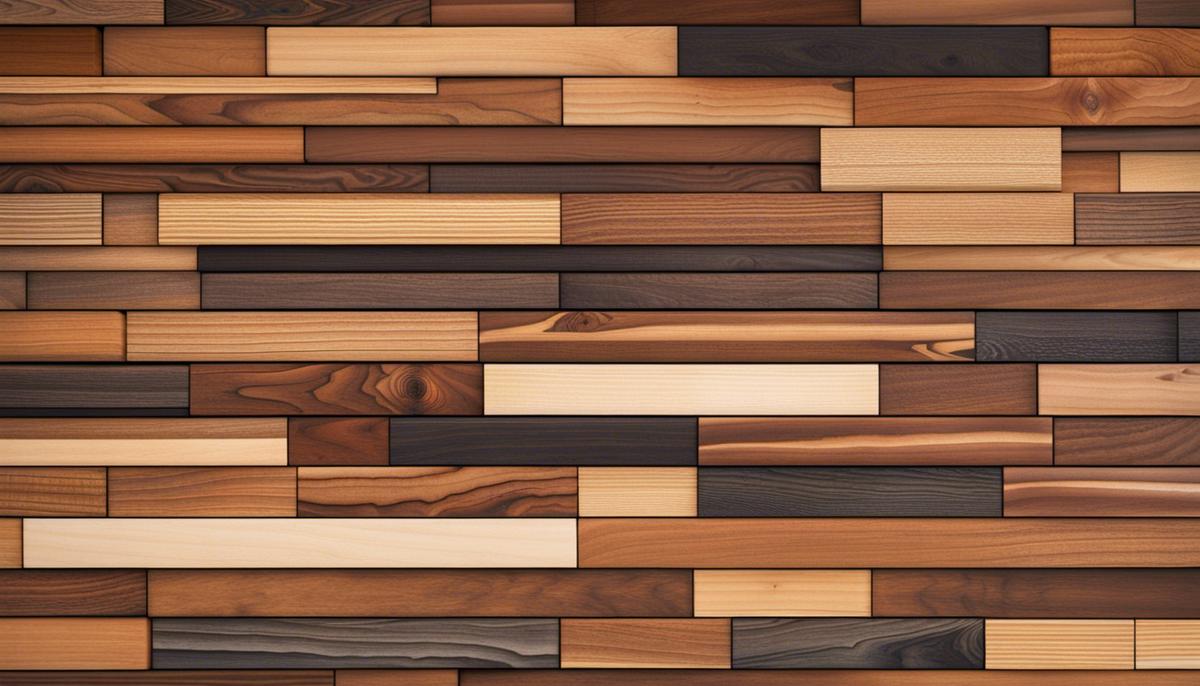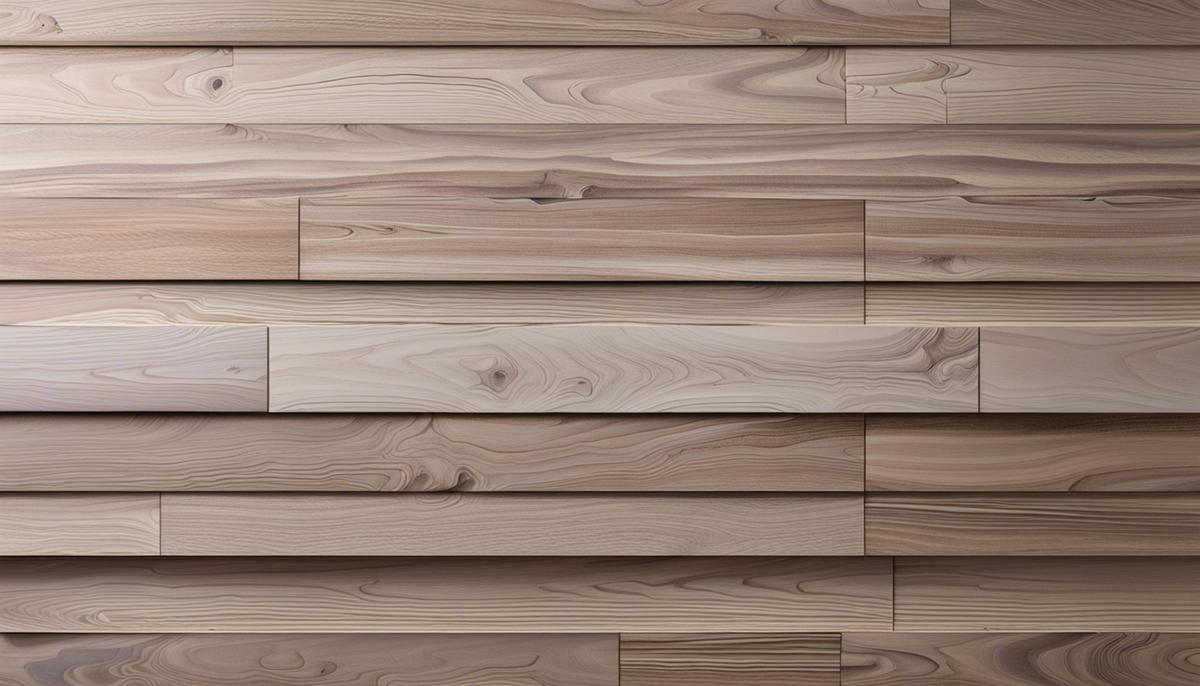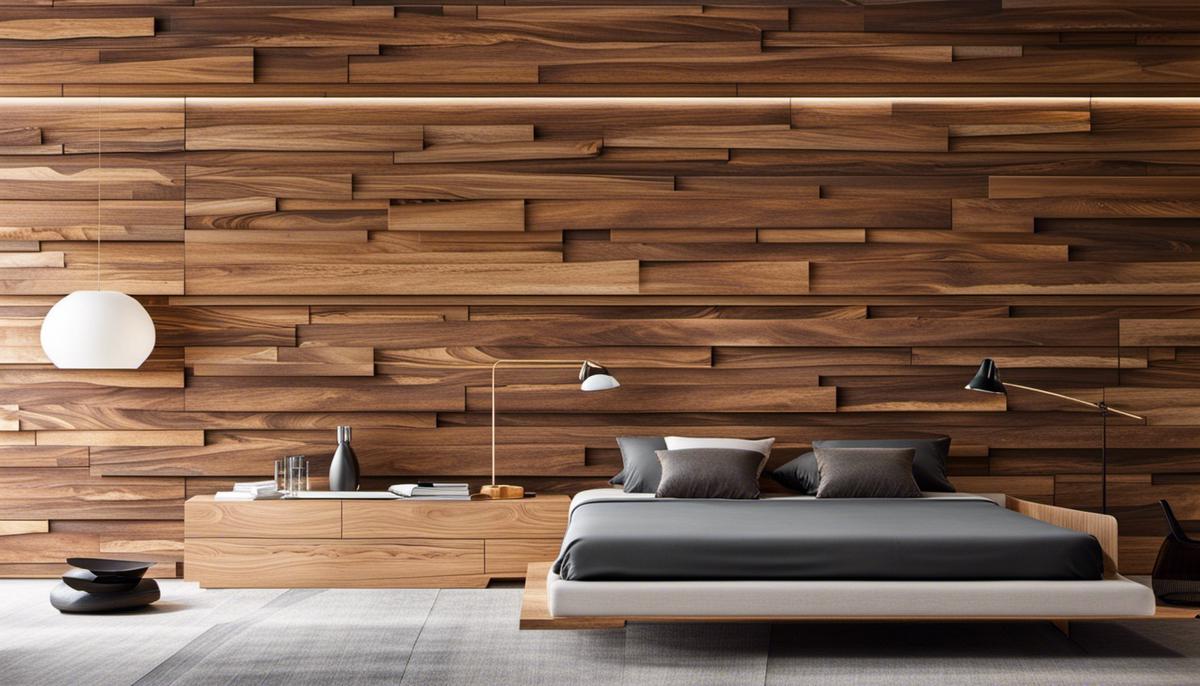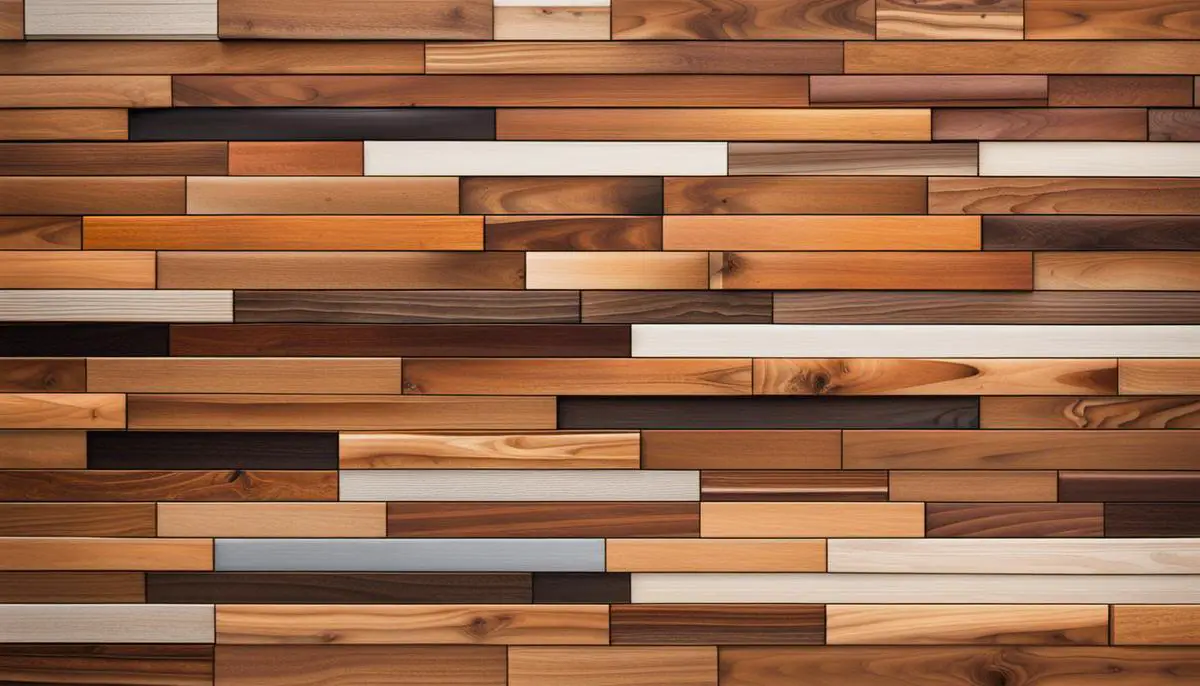Embracing the charm and elegance of wood on walls can transform your home’s interior from simple to rustic or sophisticated.
This resource is designed to guide you through the diverse world of wood wall design, highlighting critical elements like the various types of wood to choose from, their benefits and how to choose the most suitable ones considering your personality, indoor climate and overall home design.
Equipped with a step-by-step installation guide, we’ll take you through the entire process of setting up your dream wall, tackling any hiccups that may arise and touching on vital safety precautions.
Finally, we’ll pivot into modern and creative wood wall design ideas, illustrating with high-quality visuals just how captivating the different styles and tones can be, inspiring you to transform various spaces in your home.
The Basics of Wood Wall Design
An Introduction to Wood Wall Designs
Infusing wood into wall designs has turned into a trendy technique because of its natural allure, variety, and versatility. Whether it’s a hip city loft or a classic country home, wood integrates impeccably due to its adaptability and endurance.
Different kinds of woods like teak, oak, pine, reclaimed barn wood, and plywood are typically chosen for wall accents, each possessing unique qualities and aesthetics.
The sturdiness and natural grain patterns of hardwoods like oak and pine make them popular, while reclaimed barn wood ebbs a rustic, old-world charm. Plywood is a relatively economical choice that can be further stylized according to personal touch.
In addition to being visually appealing, wood provides numerous advantages. From simple, straight-lined horizontal and vertical installations to more intricate designs like chevron or herringbone, wood serves versatile design possibilities.
It is also an amazing insulator, promoting energy efficiency by keeping homes cool in summer and warm in winter. Furthermore, when well-maintained, wood ensures longevity and value addition to the property.
The selection of wood should be done keeping in mind personal style preferences and the particular room’s environment, where it will be installed. High-traffic areas or ones with more moisture might benefit from hardwoods, while lesser active zones can have softer woods.
Further scrutiny needs to be done on the wood color, so it complements the existing interior. If a lighter tone is desired, selections like pine or birch are favorable, while deeper tones can be achieved using walnut or mahogany.
Remember, the indoor atmosphere is also an important consideration as wood reacts to temperature and humidity changes. Woods like cedar and teak are known for their weather resistance and are suitable for areas with varying indoor climate.
Integrating wood features into your overall home design enhances both aesthetics and function.
From a notable living room wall to a subtle bedroom accent, wood can heighten the overall appeal of your space. However, it’s crucial to maintain a balance with other design elements like color schemes and lighting to maximize its impact.
Well-planned and implemented wood accent walls can serve as an impressive, lasting design feature to enrich the character of your home while also providing practical benefits, making it indispensable to comprehend the essence of wood wall designs for anyone considering such an approach.

Step-by-Step Installation Guide
Preparing Your Wall for Wood Panel Installation
Prior to embarking on the installation journey of wooden panels, the wall should be properly prepared.
Initiating with a thorough cleaning of the wall to eliminate any dust, grease, or residual paint that might hinder the adhesive or screws that will secure the wood. In case the wall is papered, the wallpaper needs to be removed.
Also, if the wall surface happens to be uneven, it may need sanding or evening out with a drywall compound to assure a smooth base for the panels.
Measuring the Space
Measure the height and width of the wall accurately to estimate the quantity of wood required.
It’s a good rule of thumb to buy extra to account for waste and off-cuts that accrue due to mistakes or imperfections in the wood.
Mark a level line where you will begin the installation, typically this is at the floor level or at the middle, depending upon the design you are planning.
Cutting the Wood
Cut the wooden panels according to the measurements. It’s recommended to use a miter saw for precision but a circular saw or handsaw can also be used with care. When cutting, remember to follow the old adage, “Measure twice, cut once.”
Attaching Wood to Wall
Attaching the wood to the wall can be done with adhesive, nails, or a combination of both. It is dependent on the type of wood and the wall surface you’re working with. For heavier wood types or uneven surfaces, use construction adhesive along with nails.
Start applying from the spot you marked during the measuring phase, this could be either from the middle of the wall or from the bottom, depending upon the design.
Continue applying the panels row by row, making sure that the rows are straight and level.
Always leave a small gap at the end of the walls, and at the ceiling and floor, to accommodate any expansion the wood may experience due to humidity or temperature variations.
Handling Common Issues
Measure and cut panels very carefully to fit around outlets, switches, or irregular areas. Scribe cuts may be required for highly irregular surfaces or to fit around molding.
Address any gaps that appear between panels with caulk, wood filler, or trim.
If one panel isn’t lying flat against the wall, remove it and check for any debris or high points on the wall that may be causing the issue.
Safety Precautions
Always wear safety glasses and a dust mask when cutting wood. Use gloves when handling rough wood to protect against splinters. If using a ladder to install higher panels, make sure it is secure.
While adhering wood to the wall, ensure the room is properly ventilated. Strong adhesives can emit fumes that can cause health issues if inhaled in a confined space.
All power tools and sharp objects should be handled carefully and kept out of reach of children. Always switch off and unplug power tools when not in use.
Conclusion
By diligently following these comprehensive step-by-step guidelines, you are well on your way to successfully install wood on your walls, thereby creating an environment that is not only warm and welcoming but also aesthetically pleasing.

Modern & Creative Wood Wall Ideas
Transform Your House with Modern Wood Wall Ideas
Building on the foundation of your newly acquired skills, consider that one of the most sought-after elements for home interior design is, in fact, wood.
Being flexible and robust, it projects a naturally warm aesthetic adaptable to numerous styles. Whether it’s delivering a touch of rustic charm or a sleek modern look, wood is an incredibly versatile material that can significantly enhance any room in your house.
Using Wood in the Living Room
Consider the living room. This is a common area often used for relaxation and entertainment.
A wood accent wall can create a comfortable, inviting atmosphere.
The natural grain and tones of wood can be harnessed to create a sense of continuity, linking the outdoors with the interior for a refreshing and open feel.
Wood types like pine, oak, or walnut can be used depending on your desired end result – pine lends itself well to a more rustic, shabby-chic look, while walnut works well in a room with a modern aesthetic.
Transforming Bedrooms with Wood Walls
In the bedroom, a wood accent wall can function as a natural focal point. Again, the type of wood chosen will largely dictate the overall mood of the room.
Lighter woods, such as pine or cedar, can brighten the room, while darker woods, such as mahogany or walnut, can give the room a cozy, comforting feel.
Wood-Clad Walls in the Kitchen
Introducing wood into your kitchen’s design can drastically change its overall look and feel.
A wooden backsplash or accent wall can break up the sterile look often associated with kitchens, adding an organic element to the space. Wooden cladding can also be styled to compliment any kitchen theme, whether rustic or modern.
The Allure of Different Wood Styles
The type of wood used is only half the story. There are numerous styles of wood cladding, each providing a unique look. Panels can be oriented horizontally, vertically or in herringbone patterns. They can be distressed for a rustic, vintage look, or kept sleek and smooth for a modern twist. They can be left in their natural tones, giving an earthy, organic feel, or they could be painted over, which can lend itself to a more contemporary, edgy look. The choice largely depends on one’s personal design aspirations and the theme of the house.
Innovative Wood Wall Design Techniques
Embracing technology in wood wall design can also create unique and engaging aesthetics. For instance, 3D wooden panels can create a dynamic, textured accent wall. Another modern approach is using reclaimed wood – this is not only environmentally friendly but also gives the wall a unique, vintage charm due to the natural weathering of the wood.
Wood Wall Ideas: Final Thoughts
The possibilities for wood wall designs are virtually endless, only limited by one’s imagination. From the type of wood used to its arrangement on the wall to the inclusion of advanced techniques, wood brings a timeless, natural charm to any designed space, creating inviting interiors to call home.
Carefully selected images of wood wall designs can further spur creativity, providing a visual reference for what can be achieved with this versatile material.

With this newfound knowledge, you are poised to expertly transform and redefine your home’s aesthetics using wood wall designs.
The understanding of different wood types, their benefits and how they align with your style preferences and home’s climate should be a beacon as you decide on what best suits you.
Having taken you through a detailed installation guide, we believe you are more than ready to translate your wood wall ideas into actual reality, regardless of the room you choose to enhance.
As presented through stunning visual references, the possibilities of creativity with wood wall designs are endless, creating a space that reflects your taste, preference, and style – a true embodiment of the phrase ‘home sweet home’.




